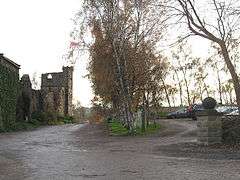Akebar
Akebar is a township and civil parish in the Richmondshire district of North Yorkshire, England, about eight miles south of Richmond. It consists of a caravan site, as well as several farm houses, a public house and folly. The civil parish as a whole consists of several farm houses. At the 2011 Census the population was less than 100. Information regarding the combined statistics can be found in the parish of Finghall.
| Akebar | |
|---|---|
 The folly and ruins at the entrance to the campsite | |
 Akebar Location within North Yorkshire | |
| OS grid reference | SE188905 |
| District | |
| Shire county | |
| Region | |
| Country | England |
| Sovereign state | United Kingdom |
| Post town | LEYBURN |
| Postcode district | DL8 |
| Police | North Yorkshire |
| Fire | North Yorkshire |
| Ambulance | Yorkshire |
History
The name of Akebar is Danish in origin and is one of Yorkshire's lost villages. It was a village settlement even before the Viking invasion when James the Deacon, a disciple of St. Paulinus, established an early church at Akebar in the 7th century AD. The present church of St. Andrew, on the edge of the park, was built in the 11th century on the position of the first church. It is still an active and well loved church.[1]
The township of Akebar was mentioned in the records of Jervaulx Abbey in 1290. It remained a grange farm for Jervaulx, a daughter monastery of the Cistercian Order at Fountains Abbey, until the dissolution of the monasteries around 1530. The Abbot and Monks of Jervaulx were well known for their excellent cheese, named Wensleydale, and famous for the breeding of horses of exceptional quality and bravery. It is recorded that a large number of their brood mares were kept at the grange farms at Akebar.[2]
References
- "A Vision of Britain Through Time: Akebar". GB Historical GIS/University of Portsmouth. Retrieved 30 January 2016.
- William Page (London, 1914) (ed.). Parishes: Fingall, in A History of the County of York North Riding: Volume 1. pp. 232–236. Retrieved 21 October 2017.